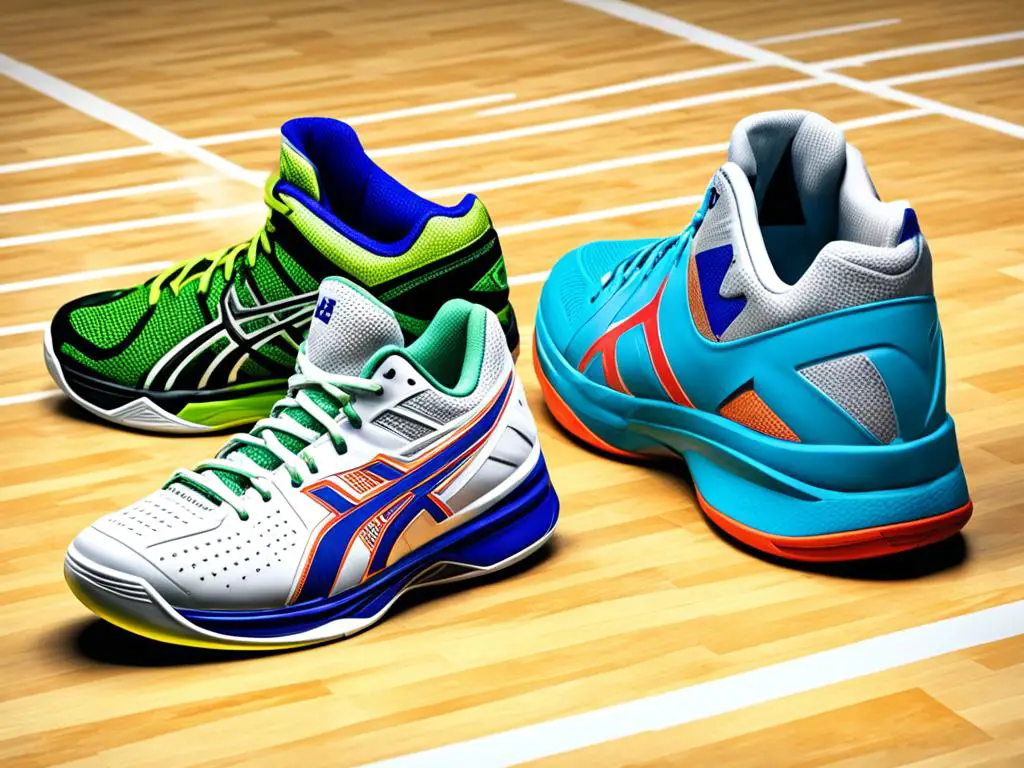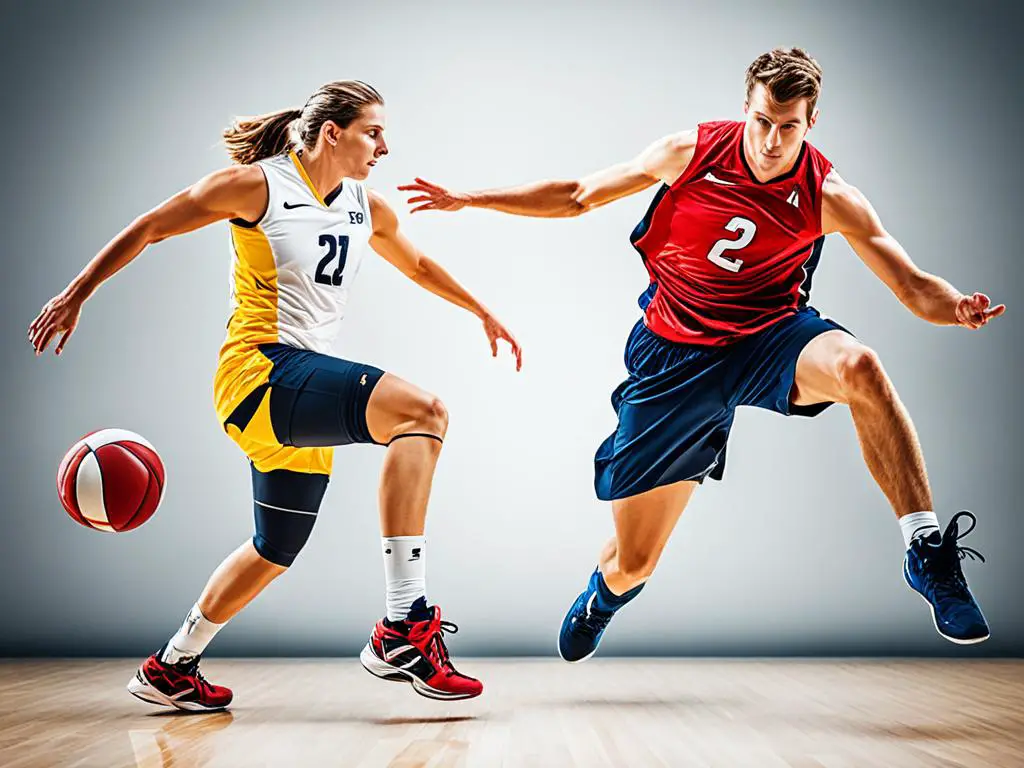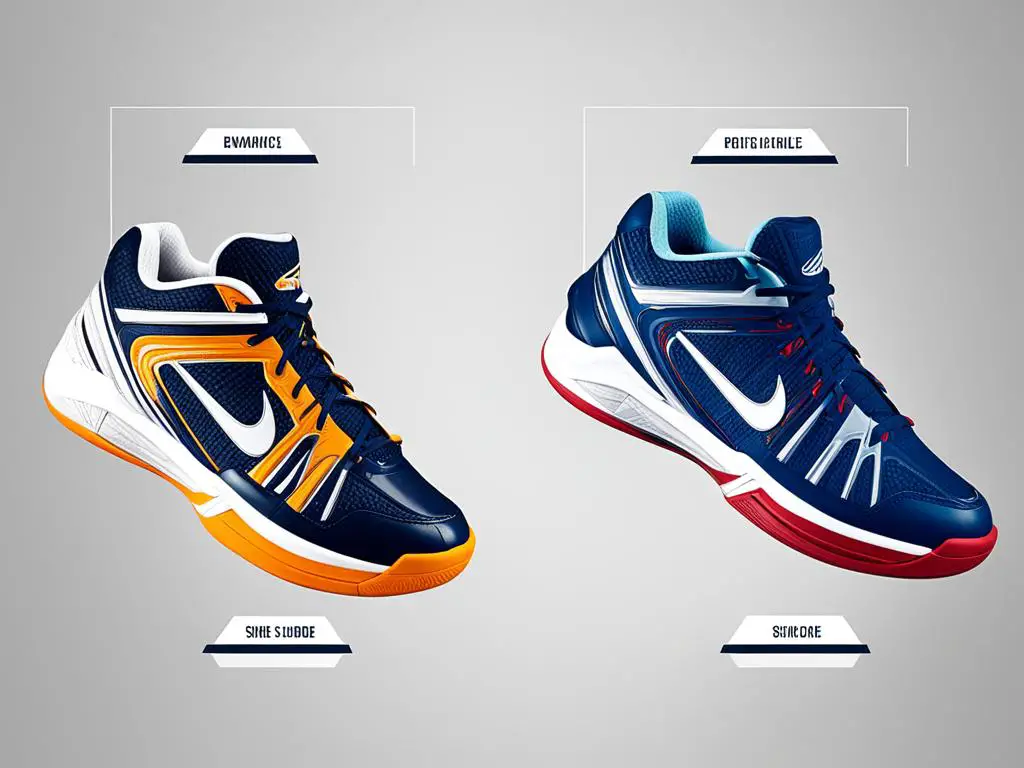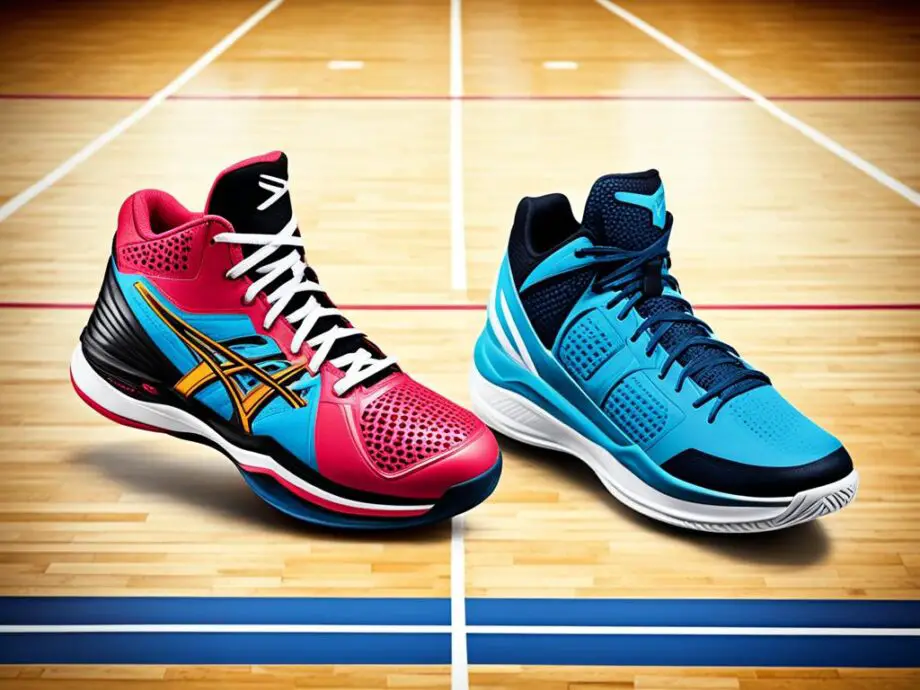When it comes to playing sports on the court, having the right footwear is crucial for performance and injury prevention. Whether you’re a volleyball enthusiast or a basketball player, choosing the right shoes can make all the difference. In this article, we will compare volleyball and basketball shoes to help you make the best decision for your athletic needs.
Key Takeaways:
- Understanding the features and technologies that make volleyball and basketball shoes unique is important when selecting athletic footwear.
- The design and construction of volleyball and basketball shoes differ in terms of fit, padding, ankle support, and traction.
- Performance attributes, such as stability, agility, cushioning, and responsiveness, play a significant role in determining the best court shoes.
- Volleyball and basketball shoes have their own pros and cons, considering factors such as versatility, durability, and overall comfort.
- When choosing between volleyball and basketball shoes, consider your playing style, foot type, and personal preferences to find the perfect fit.
Understanding the Sports Shoes Market
Before diving into the comparison between volleyball and basketball shoes, it’s important to have a solid understanding of the features and technologies that make each type of footwear unique. This knowledge will help you make an informed decision when selecting the right athletic shoes for your preferred sport.
When it comes to volleyball footwear, here’s a helpful guide to consider:
- Lightweight Design: Volleyball shoes are designed to be lightweight, allowing players to move quickly and easily on the court.
- Enhanced Traction: The outsoles of volleyball shoes provide excellent grip on indoor surfaces, ensuring stability during lateral movements.
- Shock Absorption: Volleyball shoes feature cushioning systems that absorb impact to protect players’ joints during jumping and landing.
- Breathable Upper: The upper material of volleyball shoes is typically made from breathable mesh, keeping the feet cool and comfortable throughout the game.
When considering basketball shoe features, keep the following in mind:
- Ankle Support: Basketball shoes often have higher collars and additional ankle support features to protect against sprains and provide stability during quick direction changes.
- Cushioning: Basketball shoes prioritize cushioning to absorb the impact of jumps and provide comfort during intense movements on the court.
- Durable Outsole: Due to the abrasive nature of outdoor basketball courts, basketball shoes are equipped with durable outsoles that can withstand the wear and tear.
- Lateral Support: Basketball shoes are designed with features that support lateral movements, providing stability during quick cuts and crossovers.
When comparing the performance of volleyball and basketball shoes, it’s important to consider their specific attributes:
“Volleyball shoes are best suited for the quick movements and agility required for volleyball, offering excellent grip for indoor courts. On the other hand, basketball shoes are designed with the ankle support and cushioning needed for the constant jumping and high-impact movements of basketball.”
To give you a clearer picture of the differences between volleyball and basketball shoes, let’s take a closer look:
| Volleyball Shoes | Basketball Shoes |
|---|---|
| Lightweight design | Higher collar for ankle support |
| Enhanced traction for indoor courts | Generous cushioning for impact absorption |
| Shock-absorbing cushioning | Durable outsole for outdoor courts |
| Breathable upper for comfort | Specific lateral support for quick cuts and crossovers |

With a clear understanding of the features and technologies that make volleyball and basketball shoes unique, you can confidently make a well-informed decision when choosing the right pair of athletic footwear for your sport.
Design and Construction
When choosing the right sports shoes for your game, understanding the design and construction is crucial. In this section, we will explore how the fit, padding, ankle support, and traction of volleyball and basketball shoes differ, and the impact these factors can have on your performance.
Fit
The fit of your sports shoes is highly important for optimal performance. Volleyball shoes typically have a snugger fit compared to basketball shoes. This snug fit allows for better control and maneuverability on the court. On the other hand, basketball shoes often provide a more relaxed fit to accommodate quick lateral movements and provide comfort throughout the game.
Padding
When it comes to cushioning and padding, both volleyball and basketball shoes offer different levels of support. Volleyball shoes prioritize extra padding in the forefoot and heel areas since volleyball players spend a significant amount of time jumping and landing. Basketball shoes, on the other hand, provide additional cushioning in the midsole to absorb the impact from constant running and jumping.
Ankle Support
Ankle injuries are common in both volleyball and basketball, but the design of the shoes aims to reduce the risk. Volleyball shoes typically feature a lower-cut design that allows for maximum ankle flexibility, promoting quick movements and agility. Conversely, basketball shoes often have a higher-cut design that offers more ankle support and stability to protect players from rolling or spraining their ankles during jumps and aggressive cuts on the court.
Traction
The traction of sports shoes is essential for maintaining grip on the court. Volleyball shoes usually have a gum rubber outsole that provides excellent grip on indoor courts, enabling players to make quick multidirectional movements. Basketball shoes, on the other hand, feature a durable rubber outsole with a herringbone pattern that offers enhanced traction and grip on both indoor and outdoor courts.
Choosing the right design and construction elements in your sports shoes can greatly enhance your performance and reduce the risk of injuries. Consider the unique fit, padding, ankle support, and traction requirements of volleyball and basketball to select the shoes that will best suit your needs.

Comparison of Volleyball and Basketball Shoe Design and Construction
| Design and Construction Elements | Volleyball Shoes | Basketball Shoes |
|---|---|---|
| Fit | Snug fit for control and maneuverability | Relaxed fit for lateral movements and comfort |
| Padding | Extra padding in forefoot and heel areas for jumping and landing | Additional cushioning in midsole for running and jumping |
| Ankle Support | Lower-cut design for ankle flexibility | Higher-cut design for ankle support and stability |
| Traction | Gum rubber outsole for excellent grip on indoor courts | Durable rubber outsole with herringbone pattern for enhanced traction on indoor and outdoor courts |
Performance on the Court
When it comes to choosing the best court shoes, comparing the performance attributes of volleyball and basketball shoes is crucial. The right footwear can have a significant impact on your game, providing the stability, agility, cushioning, and responsiveness needed to excel in your sport of choice.
Let’s take a closer look at how volleyball and basketball shoes measure up when it comes to performance:
Stability
Both volleyball and basketball shoes are designed to provide stability on the court. However, there are some key differences in their construction that cater to the specific demands of each sport.
Volleyball shoes often feature a low-profile design with a wide base, offering excellent lateral stability and preventing ankle injuries during quick lateral movements. On the other hand, basketball shoes typically have a higher collar for enhanced support and stability during the frequent jumps and landing associated with the sport.
Agility
Agility is a crucial aspect of both volleyball and basketball. Quick directional changes, explosive movements, and rapid acceleration and deceleration are common in both sports.
Volleyball shoes are often lightweight and flexible, allowing players to move swiftly across the court and make agile jumps at the net. Basketball shoes, on the other hand, provide a balance between flexibility and support to accommodate the multidirectional movements and aggressive playstyle of basketball.
Cushioning
The level of cushioning in sports shoes plays a vital role in minimizing impact and protecting joints during high-intensity movements on the court.
Volleyball shoes typically have responsive cushioning in the forefoot area, ensuring excellent shock absorption during jumps and quick movements. Basketball shoes, on the other hand, often feature additional cushioning in the heel to support the frequent landings and provide shock absorption during aggressive plays.
Responsiveness
Responsiveness refers to how well the shoe translates the energy from your movements into the court, enabling quick and explosive plays.
Volleyball shoes are designed to provide a high level of responsiveness, allowing players to quickly transition from one movement to another. Basketball shoes, on the other hand, focus on providing a balance between responsiveness and impact absorption, considering the frequent jumps and landings in the sport.
Considering these performance attributes will help you make an informed decision when choosing between volleyball and basketball shoes. Tailoring your footwear to the specific demands of your preferred sport can significantly enhance your performance on the court.

| Volleyball Shoes | Basketball Shoes | |
|---|---|---|
| Stability | Low-profile design with wide base for lateral stability | Higher collar for enhanced ankle support and stability during jumps |
| Agility | Lightweight and flexible for swift movements and jumps | Balance between flexibility and support for multidirectional movements |
| Cushioning | Responsive cushioning in the forefoot area for shock absorption | Additional cushioning in the heel for shock absorption during landings |
| Responsiveness | High level of responsiveness for quick transitions | Balance between responsiveness and impact absorption |
Volleyball Shoes vs Basketball Shoes: Pros and Cons
When it comes to choosing the right sports shoes, it’s essential to consider the specific needs of your sport. Volleyball and basketball require different types of footwear that cater to the unique demands of each game. In this section, we will explore the pros and cons of volleyball shoes and basketball shoes, helping you make an informed decision before hitting the court.
Volleyball Shoes
Volleyball shoes are specially designed to provide players with the stability, agility, and support needed for quick movements on the court. Here are the key advantages and disadvantages of volleyball shoes:
| Pros | Cons |
|---|---|
| 1. Excellent traction for quick lateral movements | 1. Limited versatility for other sports or activities |
| 2. Lightweight construction for enhanced agility | 2. Less cushioning compared to basketball shoes |
| 3. Extra ankle support to prevent injuries | 3. Potentially less durable due to specialized design |
Overall, volleyball shoes offer exceptional performance on the court, providing the necessary features for explosive movements and quick changes in direction. However, their limited versatility and slightly reduced cushioning may make them less suitable for activities outside of volleyball.
Basketball Shoes
Designed for the fast-paced, high-impact nature of the game, basketball shoes offer unique features to maximize performance and protect players from injuries. Let’s review the pros and cons of basketball shoes:
| Pros | Cons |
|---|---|
| 1. Versatile for various sports and activities | 1. Traction may not be as ideal for lateral movements |
| 2. Superior cushioning for excellent shock absorption | 2. Heavier weight compared to volleyball shoes |
| 3. All-round support for enhanced stability | 3. Slightly reduced ankle mobility due to higher collars |
Basketball shoes offer a balance of support, cushioning, and versatility, making them suitable for a range of court-based sports and activities. While they may not provide the same level of lateral traction as volleyball shoes, basketball footwear excels in overall cushioning and stability.
Ultimately, the choice between volleyball shoes and basketball shoes depends on your specific needs and preferences. Consider the demands of your sport, playing style, and comfort requirements to determine which type of shoe will best enhance your performance on the court.
Next, we will explore some practical tips and guidelines to help you make an informed decision when choosing the right sports shoes for your needs.
Choosing the Right Shoes for You
When it comes to choosing the right sports shoes, there are several factors to consider. Whether you’re a volleyball player or a basketball enthusiast, finding the best athletic footwear is crucial for optimal performance on the court. In this section, we will provide practical tips and guidelines to help you make an informed decision.
1. Know Your Playing Style
Your playing style can greatly influence the type of shoes you should choose. If you’re an aggressive player who makes quick lateral movements and sharp cuts, basketball shoes with excellent ankle support and stability are essential. On the other hand, if you’re a volleyball player who relies on agility and quick movements, lightweight shoes with more flexibility and responsiveness would be your best bet.
2. Consider Your Foot Type
Every individual has a unique foot type, which can impact the comfort and fit of sports shoes. If you have high arches, look for shoes with ample cushioning and support to alleviate pressure on your feet. Flat-footed individuals may benefit from shoes with arch support and stability features. Understanding your foot type will help you find shoes that provide the necessary support and prevent injuries.
3. Prioritize Comfort
Comfort should be a top priority when choosing athletic footwear. Ill-fitting shoes can lead to discomfort, blisters, and even injuries. Take the time to try on different models and brands, paying attention to the width, toe box, and overall fit. Look for shoes with breathable materials and padded insoles to enhance comfort during long hours of play.
4. Factor in Personal Preferences
Personal preferences also play a role in choosing the right sports shoes. Some players prefer a snug fit, while others prefer a bit more room for toe movement. Consider the aesthetics as well, as feeling confident in your footwear can contribute to your overall performance on the court.
5. Seek Expert Advice
If you’re unsure about which shoes to choose, don’t hesitate to seek advice from experts such as professional coaches, podiatrists, or experienced athletes. They can provide valuable insights and recommendations based on your specific needs and goals.
By considering your playing style, foot type, comfort, personal preferences, and seeking expert advice, you can confidently make the right choice when selecting between volleyball and basketball shoes. Remember, the best athletic footwear is the one that suits you and enhances your performance on the court.
Comparison of Volleyball and Basketball Shoes
| Features | Volleyball Shoes | Basketball Shoes |
|---|---|---|
| Ankle Support | Good | Excellent |
| Traction | Designed for indoor courts | Excellent grip on various surfaces |
| Cushioning | Responsive and lightweight | Ample cushioning for impact protection |
| Stability | Focused on lateral movements | Optimized for quick directional changes |
| Weight | Lightweight | Slightly heavier due to added support |
Conclusion
When it comes to choosing the right athletic footwear for your preferred sport, understanding the differences between volleyball and basketball shoes is crucial. By evaluating the design, performance, pros and cons, and your individual needs, you can confidently select the best court shoes.
Volleyball shoes are designed to provide excellent cushioning and support, allowing players to move quickly and make precise movements on the court. They offer specialized features such as enhanced traction for indoor surfaces and additional padding around the forefoot to support frequent jumps and landings.
On the other hand, basketball shoes focus on delivering superior ankle support and stability to help players navigate sudden changes in direction and perform explosive movements. These shoes often have thicker, more rigid soles and provide excellent grip on both indoor and outdoor courts.
Ultimately, the best athletic footwear depends on your specific needs and playing style. Whether you’re a volleyball player seeking optimal cushioning and agility or a basketball player aiming for ankle protection and stability, there is a shoe that will enhance your performance and keep you comfortable throughout the game.
